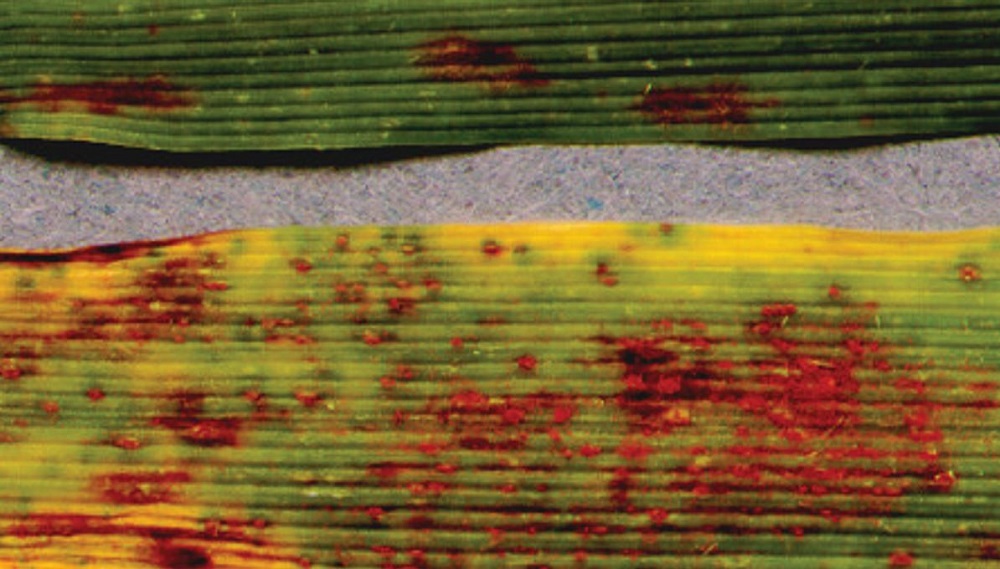A ‘ubiquitous’ future for early crop disease detection?
Wednesday, 22 June 2022
Crop immune responses to pathogen infection have been pulled apart by researchers. Their findings could help revolutionise the way disease is detected – and it’s all about ‘ubiquitination’
The immune response
Despite diseases infecting crops for hundreds of years, relatively little is known about the way plants respond to attack. Led by Beatriz Orosa at the University of Edinburgh, new research results have delivered a far better understanding of natural defences (the immune response) in a commercial crop – spring barley.
The coronavirus pandemic has ensured that ‘immunity’ has been a hot topic of conversation for almost three years. Inevitably, the complex processes associated with it are different in plants than animals*. However, photosynthetic organisms do also possess defence systems and examining how they work may unlock new approaches to disease control.
However, it is not an easy area of science – especially when the dynamic interactions between the pathogen and the host are considered.
A successful immune response requires the crop to recognise the signs of attack and unleash an array of pathogen-countering responses.
And interactions are not static. Pathogens constantly evolve to avoid host resistance (or any other plant protection strategy). For example, some pathogens adapt and release molecules to suppress host immune responses to increase the chance of successful infection.
The ubiquitin pathway
To research this complex area, it is important to keep things as straightforward as possible. The team’s preliminary work focused on Arabidopsis thaliana. From the mustard family, this small plant is a favourite for plant studies. From a genetic perspective, it is a relatively simple – it is also easy and quick to grow.
They investigated the ubiquitin pathway – a brow-furrowing pathway in terms of its complexity – which is associated with two key technical terms:
- Ubiquitin: a protein found in many organisms involved in the regulation of plant immune responses.
- Ubiquitination: a fast and reversible protein modification that regulates the type, strength, and speed of the immune response.
The ubiquitin pathway was found to be essential in the activation of the immune response in Arabidopsis thaliana.
Barley brown rust
The latest project explored whether the ubiquitin pathway is similar in other plants, specifically in those of commercial interest – such as spring barley infected by the brown rust pathogen.
Brown rust tends to be more problematic in winter barley. This has given breeders extra incentive to bolster resistance to the pathogen – with disease resistance scores of up to 8 in the Recommended Lists (2022/23), compared to a maximum of 5 for spring barley. As a result, the researchers focused on spring barley to help lead to strengthened defence.
When two plant stress hormones (salicylic acid (SA) and jasmonic acid (JA)) were applied to spring barley cultivars, the researchers observed an accumulation of ubiquitinated proteins – like the responses observed in arabidopsis. They identified a 146 and 67 SA-dependent and JA-dependent ubiquitinated proteins, respectively.
Field trial results also showed a general ubiquitin-mediated immune activation in all barley cultivars infected by the brown rust pathogen. This implies that ubiquitin regulation of the immune system is a conserved mechanism across cultivars.
Furthermore, the accumulation of ubiquitin targets correlated with the performance in the field trial, suggesting wide-spread substrate ubiquitination is a key aspect of the immune response.
Their results indicate that the development of markers for ubiquitination could be used to quantify early pathogen infection.
The team plans to design a method, which uses a green fluorescent protein (GFP), to measure the accumulation of ubiquitinated proteins during infection.
It is a tantalising prospect – monitoring activity within this pathway could lead to a major advance in disease management.
In theory, it is possible to detect infection long before visible symptoms appear in crops, helping to facilitate protectant fungicide use. Rapid detection would also help speed up plant breeding programmes.
Read the 'Improving crop immunity to foliar diseases by exploitation of the ubiquitin system' report
AHDB/BBSRC net-zero partnership
This project was part of an AHDB/BBSRC partnership that aimed to support the agricultural transition to net zero.
Project costs were met through BBSRC’s Farm Sustainability Fund. The partnership supported ten projects that addressed priorities identified by farmers, including ways to cut greenhouse gas emissions and increase carbon storage.
*Note: Unlike animals, plants are not able to form antibodies. Therefore, genetic resistance is more important in plants because they can’t ‘learn’ to defend themselves.



